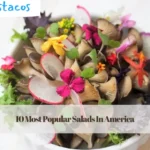In the world of gastronomy, salads offer a canvas of flavors and textures that captivate our palates. Beyond being mere appetizers, these culinary creations tell stories of cultural influences, historical origins, and the brilliance of innovative chefs. Let’s embark on a delectable journey through some internationally renowned salads, each a masterpiece in its own right.
1. Chinese Chicken Salad: A Fusion Delight
Unveiling the American Twist
Contrary to its name, Chinese chicken salad has its roots in American soil. Legend has it that the culinary maestro Wolfgang Puck, an Austrian chef specializing in Asian fusion cuisine, birthed this creation. Others assert its inception during the 1930s within the United States, adding an air of mystery to its origin story.
The Melting Pot on a Plate
Comprising shredded chicken, crisp lettuce, assorted vegetables, fried noodles, and almonds, this salad has become a staple across the United States. The ‘Chinese’ in its name is a nod to the infusion of Chinese-style seasonings such as soy, sesame, and ginger, harmonizing diverse flavors on a single plate.
2. Tabbouleh: A Symphony of Lebanese Flavors
From the Mountains of Lebanon to Your Plate
Tabbouleh, a vibrant Lebanese national dish, stands out as a crunchy and chewy salad. Born in the mountains of Lebanon and Syria, it features finely chopped parsley leaves, olive oil, bulgur wheat, and mint leaves. Arabs have savored the herbs used in tabbouleh since Medieval times.
A Palette of Flavors
Traditionally served as an appetizer, tabbouleh offers a burst of freshness. Accompanied by pita bread, baba ghanoush, or hummus, this salad welcomes additions like red tomatoes, cucumbers, lemon juice, and minced onions, creating a tangy symphony. For an optimal taste experience, refrigerate tabbouleh before serving.
3. Som Tam: Thailand’s Green Papaya Extravaganza
Spreading from Isaan to the World
Hailing from northeastern Thailand, Som Tam, a green papaya salad, is a tantalizing blend of flavors. While its roots are linked to Laos, the salad comprises green papaya strips, roasted peanuts, green beans, tomatoes, and a zesty sauce featuring garlic, chili peppers, fish sauce, dried shrimps, palm sugar, and lime or tamarind juice.
Endless Varieties
The allure of Som Tam lies in its versatility. Restaurants and street stalls offer a plethora of choices, allowing patrons to customize ingredients and tweak the sauce’s sweetness and spiciness. A testament to culinary creativity, this Thai delight offers a unique experience with every bite.
4. Olivier Salad: Russia’s New Year’s Tradition
A Historic Appetizer
Olivier salad, a Russian delicacy, boasts a rich history and a variable ingredient list. Typically comprising diced potatoes, vegetables, eggs, and a generous dollop of mayonnaise, it has become a New Year’s staple in Russia and some former USSR countries.
A Stolen Recipe Lives On
Invented in the 1860s by Lucien Olivier, a Moscow-based chef, the salad’s recipe was guarded until his demise. Despite an alleged theft, the Olivier salad continues to grace tables, carrying the legacy of a bygone era into contemporary festivities.
5. Fattoush: Levantine Elegance on Your Plate
A Symphony of Levantine Flavors
Fattoush, a simple yet elegant salad, centers around traditional pita bread. Tear or cut the bread into bite-sized pieces, toast, grill, or fry it, then mix it with a medley of vegetables like lettuce, radish, cucumber, tomatoes, peppers, onions, and, occasionally, garlic.
Sumac’s Signature Touch
Elevating the salad is sumac, a spice commonly used in the Levantine region. The dressing, a blend of olive oil, lemon juice, and pomegranate syrup, adds a final flourish. Fattoush embodies the essence of Levantine cuisine, a harmonious blend of flavors and textures.
6. Macaroni Salad: A Hawaiian Necessity
A Cool Hawaiian Indulgence
A ubiquitous presence in Hawaiian plate lunches, macaroni salad is a delightful mix of tanginess and sweetness. Comprising overcooked elbow macaroni dressed with milk-thinned mayonnaise, it emerged in the early 1980s, gaining popularity with the Nouvelle Cuisine movement.
Nouvelle Cuisine Evolution
While some trace its roots to the early 20th century, macaroni salad became a culinary icon during the 1980s. The pasta’s intentional overcooking ensures it absorbs the dressing, creating a symphony of flavors in every bite.
7. Caprese Salad: Neapolitan Sunshine on a Plate
A Taste of Summer in Southern Italy
Radiating the essence of southern Italy’s summer, the insalata Caprese is a timeless Neapolitan classic. Ripe tomatoes, creamy mozzarella, and fresh basil come together in perfect harmony. Originating from the island of Capri, this salad remains true to its roots.
Tomatoes, Mozzarella, and Basil Bliss
Originally featuring Re Umberto or Fiascone tomatoes and treccia di Sorrento, a braided mozzarella, the authentic Caprese salad recipe omits balsamic or other vinegars. This culinary gem captures the sun-soaked flavors of the Amalfi coast.
8. Greek Salad: A Culinary Odyssey
From the Fields to the Table
Known as village salad or horiatiki, the Greek salad stands as Greece’s national dish. Quartered tomatoes, sliced red onions, cucumber slices, and olives form the foundation. The addition of feta cheese, oregano, salt, pepper, and an olive oil and lemon or vinegar dressing enriches the experience.
A Rural Culinary Tradition
Reflecting its name, the Greek salad embodies a rustic charm, reminiscent of farmers taking essential ingredients to the fields. The simplicity of its components belies the complexity of flavors that dance on the taste buds.
9. Caesar Salad: Tijuana’s Culinary Triumph
Prohibition Era Innovation
Named after its creator Cesare (Caesar) Cardini, the Caesar salad emerged during the Prohibition era in the 1920s. Cardini, an Italian immigrant operating a popular restaurant in Tijuana, crafted this iconic dish through ingenuity and improvisation.
Tijuana’s Culinary Legacy
As Tijuana flourished with Californians seeking refuge from Prohibition, the Caesar salad gained fame. A testament to inventive culinary spirit, it remains a global favorite, capturing the essence of an era marked by creativity and indulgence.
10. Coleslaw: Dutch Roots, American Staple
Evolution of a Cabbage Salad
Derived from the Dutch term “koolsla,” meaning cabbage salad, coleslaw has evolved into an American culinary fixture. Introduced to New York state by Dutch settlers in the 18th century, it features shredded cabbage, mayonnaise, carrots, and a medley of seasonings.
A Symphony of Ingredients
Coleslaw’s charm lies in its diversity. Various regional variations introduce ingredients like buttermilk, sour cream, vinegar, sugar, and additional components such as celery seeds, grated cheese, pineapple, or peppers. This ever-adapting dish reflects the rich tapestry of American culinary traditions.
Culinary Chronicles: Salads Beyond Borders
From the vibrant fusion of Chinese chicken salad to the sun-soaked simplicity of Caprese, each salad weaves a culinary narrative. These diverse creations, shaped by history, culture, and innovation, showcase the global appeal of salads. As we savor each bite, we embark on a journey through time and taste, celebrating the artistry that turns simple ingredients into gastronomic masterpieces.





